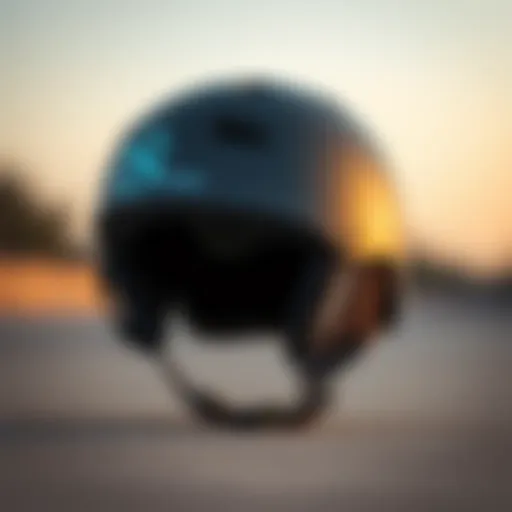Hi Skate Shoes: A Deep Dive into Skate Culture
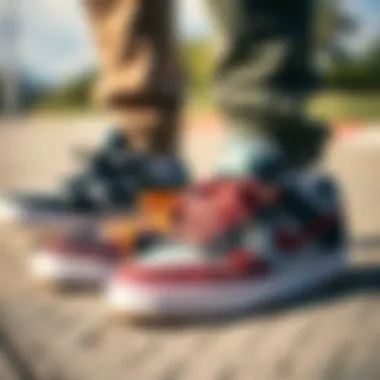
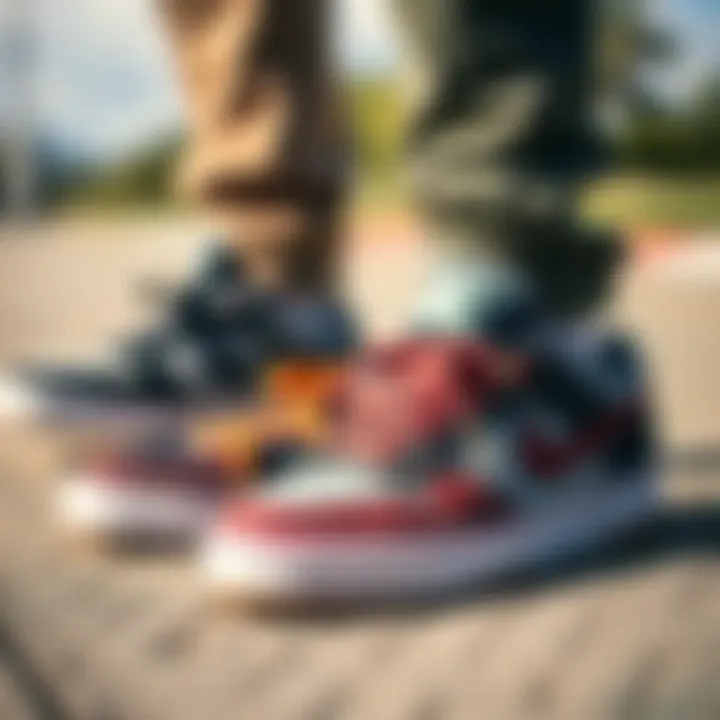
Intro
In the vibrant world of skateboarding, shoes play a vital role, bridging the gap between style and function. Skate shoes are not just footwear; they are essential tools for skaters, influencing performance, safety, and personal flair. Whether you’re a seasoned pro or just starting out, understanding the complexities of skate shoes can significantly enhance your experience on the board.
From the first pairs of durable designs meant for protection to today’s advanced models catering to the unique demands of various tricks and terrain, the evolution of skate shoes reflects both technological innovation and cultural shifts. Let’s embark on a thorough exploration of these sneakers that have made their mark both on and off the skatepark, ensuring that everyone from casual riders to serious enthusiasts can gain valuable knowledge and insight.
Skateboarding Techniques
Mastering the Basics
For any skater, mastering the basics is crucial. It's not merely about standing on the board; understanding the right stance, foot placement, and balance can make or break your ride. A solid foundation can lead to improved skills and confidence when taking those first dives into trick-land.
The most fundamental technique is the ollie. This trick allows a skater to pop the board off the ground, setting the stage for many other tricks. To perform a successful ollie, skaters must position their back foot on the tail and apply pressure while dragging the front foot upwards.
Advanced Tricks and Stunts
Once the basics are down, skaters often look to push their limits with more advanced tricks. Tricks such as kickflips, heelflips, and grinds require not only talent but appropriate footwear that provides enough grip and flexibility. High-quality skate shoes often come equipped with features like reinforced stitching and cushioned insoles which are essential for supporting a skater's feet during intense maneuvers.
Choosing the right skate shoe can directly impact your performance. Well-made shoes offer not just style but also durability and functionality. Low-top shoes, for example, allow for greater ankle mobility suited for tricks, while high-tops provide extra support and protection for those learning or executing complex sequences.
Gear and Equipment
Skateboard Types and Features
The choice of skateboard can also significantly influence a skater's experience. There are several types of boards, including:
- Cruisers: Suitable for casual riding; they typically have wider decks and softer wheels for comfort.
- Street Boards: Designed for tricks and tricks on urban terrain. They are generally shorter and have a harder wheel base.
- Longboards: Known for stability and ride length, these are not often used for tricks but excel in long-distance travel and downhill rides.
Understanding the specifications of each board type ensures that a skater can match their style and skills effectively.
Essential Safety Gear
No discussion about skating would be complete without mentioning safety gear. Protecting oneself while practicing or performing can mean the difference between a few scrapes and serious injury.
- Helmets: A staple for any skater, it’s vital for head protection.
- Knee and Elbow Pads: These add layers of protection against falls, particularly for beginners learning new skills.
- Wrist Guards: They can save the wrists from serious injuries, especially during those first few runs.
Skateboarding can be a thrilling yet precarious activity. Therefore, it’s crucial to invest in both quality skate shoes and safety gear to ensure not just performance but also safety on the board. A comprehensive understanding of the gear paves the way for a more enjoyable skating journey.
Investing time in understanding your footwear can lead to greater performance and style.
Intro to Skate Shoes
Skate shoes have become more than just a necessity for skateboarders; they represent a unique blend of culture, history, and performance. This article seeks to explore the vital role that skate shoes play in the world of skateboarding, scrutinizing both their evolution throughout time and the features that make them indispensable for anyone who rides a board.
To fully appreciate skate shoes, one must understand the history behind them. The bikers of the 1960s and 70s laid the groundwork for what would soon flourish into a thriving skateboarding scene. Manufacturers started pouring resources into crafting shoes that not only showcased style but also offered the required functionalities. Think of it—it’s like having a trusty steed for a cowboy; the shoe is not just an accessory, it's essential equipment for every skater navigating the urban landscape.
The defining features of a good skate shoe offer both form and function. You wouldn’t don a pair of flip-flops to go rock climbing, just as you wouldn’t choose a conventional sneaker for a day of shredding at the park. So, what is it that sets skate shoes apart? Sturdy construction, specialized grip technology, and ergonomic design—these attributes create a reliable foundation, enabling riders to express themselves through their tricks and style. It's not merely about keeping your footing; it's a matter of expressing individuality, comfort, and performance, which skaters treasure.
Using skate shoes enhances performance in myriad ways, from improved grip that reduces slips during complex tricks, to cushioning that absorbs the shocks of landing. With the right information and considerations, skateboarders, parents, and retailers alike can make informed choices about which skate shoes will serve their needs best.
"The shoes you choose will not just carry you; they'll define your ride."
In the sections that follow, we’ll further dissect the historical context of skate shoes and delve into the key features that make them an essential part of skate culture. This exploration is not only aimed at serious enthusiasts but also at casual riders and novices eager to understand their gear better.
Importance of Skate Shoes in Performance
Skateboarding is not merely about style or show; it's about performance and precision. When skaters choose their footwear, they are not just unveiling a fashion statement but rather enhancing their overall performance. The right pair of skate shoes can make or break a skater’s experience on the board. Let's dive into two critical components that play a pivotal role in skate shoe performance: grip technology and cushioning.
Grip Technology
One of the most vital aspects of skate shoes is the grip technology. The sole of a skate shoe is engineered to provide maximum traction, crucial for executing tricks and maintaining control during intense maneuvers. Different brands leverage unique rubber compounds and tread patterns to optimize grip.
For example, consider the revolution brought by the Vans Waffle outsole. Its hexagonal pattern allows for superior grip while still being flexible enough to accommodate the natural foot movements during skateboarding. This traction not only helps skaters land tricks but also minimizes the risk of slipping, a common concern when performing on different surfaces.
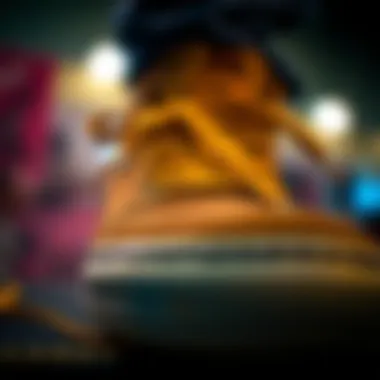
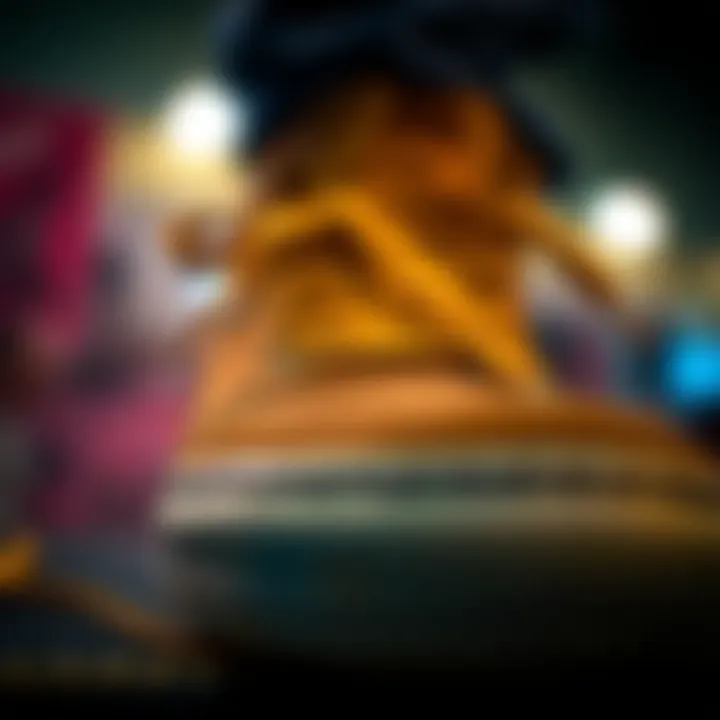
‘Without the right grip, even the best skater can feel like they are skating on ice.’ - Anonymous Skateboarder
In addition to the outsole design, the quality of the rubber itself plays a role in how shoes perform. Softer rubbers tend to offer better grip but usually wear down faster. Harder rubbers, on the other hand, are more durable but can sometimes compromise traction. It's a balancing act that each skater must consider when selecting their gear.
Cushioning and Support
The cushioning and support provided by skate shoes directly influences a skater's comfort and longevity on the board. A well-cushioned shoe absorbs impact, reducing the strain on joints during jumps and harsh landings. This technology can provide crucial shock absorption, helping skaters push through longer sessions without excessive fatigue.
Many brands incorporate modern materials like EVA foam or gel inserts, which provide varying levels of cushioning designed for different skate styles. For instance, a skater focused on street tricks might prioritize lighter shoes with more responsiveness, while someone into ramp skating might prefer more padding for added protection.
The ankle support also can’t be overlooked. Some skates come in high-top designs to provide additional support for the ankle joint, essential for preventing injury during aggressive movements. However, some skaters may find low-tops offer better flexibility and performance. Again, this factor varies by individual preference and skate style.
In summary, understanding grip technology and the importance of cushioning can drastically affect a skater's performance. It's not merely about looking good on the board; it's about making informed choices on which features best cater to your skating style and personal needs. As the skateboarding scene continues to evolve, knowledge of these functional aspects will empower skaters to make better decisions about their footwear.
Top Skate Shoe Brands
When it comes to skate shoes, the brands that dominate the market play a pivotal role in shaping not only footwear options but also the culture surrounding skateboarding. Each brand brings its unique flair and innovations to the table, allowing skaters from all walks of life to express themselves through their choice of footwear. The right pair of skate shoes can significantly impact performance, comfort, and style, and understanding these brands can guide skateboarders, parents, and retailers in making informed selections.
Nike SB: Innovation and Style
Nike SB is a powerhouse in the skate shoe industry, renowned for its commitment to blending cutting-edge technology with contemporary style. The shoes produced under Nike SB's brand are often characterized by their superior grip and durability, reflecting the brand's desire to support skaters not just in aesthetic, but also in functional aspects. Models like the Nike SB Dunk have set standards for both casual wear and performance.
Moreover, Nike SB often collaborates with professional skaters, enhancing their shoes with feedback directly from the skate park. This relationship not only leads to innovative solutions in skate shoe technology but also cultivates a community that appreciates the artistry behind design as much as the sport itself.
Vans: A Cultural Icon
Vans holds a celebrated position in skate culture, often regarded as synonymous with the sport itself. The brand has built a legacy through its classic designs and timeless silhouettes, such as the Old Skool and Sk8-Hi. It’s not simply about function with Vans; wearing them has become a statement of lifestyle and individuality.
Skaters of all ages are drawn to Vans for not only their performance but also their adaptability to fashion trends. Their canvas and suede materials are both stylish and practical, providing a level of comfort essential for long days spent skating at the park. Vans' iconic checkerboard pattern is an emblem of skate culture itself, making it a popular choice among enthusiasts.
Adidas Skateboarding: Blending Performance with Lifestyle
Adidas Skateboarding represents a merger of athletic performance and street style. Their skate shoe lineup often reflects their heritage in sports while successfully translating that into a skate context. Models like the Adidas Busenitz and Adizero showcase cutting-edge technologies that enhance breathability and comfort for skaters.
What sets Adidas apart is their attention to the needs of the modern skater—they continue to innovate while recognizing the importance of visual appeal. This dual focus makes their shoes a favorite for those who skate, but also for casual wearers looking to amplify their urban outfits. Adidas’s partnership with professional skaters allows them to create footwear that meets specific performance criteria while resonating with contemporary fashion trends.
Emerica: Focusing on Functionality
Emerica may not be as ubiquitous as the others, but it has carved out a niche for itself by emphasizing functionality above all else. The brand is known for its commitment to creating skate shoes tailored specifically to skaters' needs. Shoes like the Emerica Romero provide a blend of comfort and durability, essential for coping with the wear and tear of skateboarding.
Emerica stands by its mission to support skateboarding's grassroots level. They remain deeply involved with their team riders, often creating shoes based directly on feedback from pro skaters. This level of direct engagement ensures that every shoe released meets the practical demands of both street skaters and park riders alike.
"Emerica believes in providing shoes that help you perform at your best, without losing touch with the roots of skate culture."
Each of these brands plays a distinctive role in shaping skate footwear options for various needs. Whether it’s standout styles, performance efficiency, or a cultural connection, skaters are equipped to find what they resonate with the most in their footwear choices. Understanding these brands enhances the purchasing experience and fuels deeper appreciation for skateboarding as both a sport and cultural phenomenon.
Selecting the Right Skate Shoe
Finding the right skate shoe isn't just about flinging a pair on your feet. It's a critical aspect that can greatly influence your skating performance and experience. Considering the specific features and benefits associated with skate shoes ensures that you choose a pair that not only complements your skating style but also supports your feet effectively.
Understanding Fit and Comfort
The fit of a skate shoe is probably one of the top factors to consider. A snug yet comfortable fit allows you to maneuver your board effortlessly. If your shoes are too tight, you may experience discomfort or even pain, which can distract you during practice or competitions. On the flip side, shoes that are too loose can lead to poor performance and risk of injury.
To ensure a good fit:
- Try before you buy: Walk around the store in the shoes. Does it feel right?
- Consider the sock thickness: Your usual choice in socks can influence how a shoe fits.
- Pay attention to lacing: Many skate shoes come with various lacing options to help achieve the ideal snugness.
In skateboarding, every flick and push counts; therefore, having shoes that feel like an extension of your feet can make all the difference. You're more likely to stick your landing when you don’t have to think about your footwear.
Assessing Durability and Material Quality
Skateboarding is an activity known for its rough and tumble nature. Skate shoes need to withstand not just the wear and tear of the asphalt but also the constant impact from jumps and tricks. Assessing durability is essential.
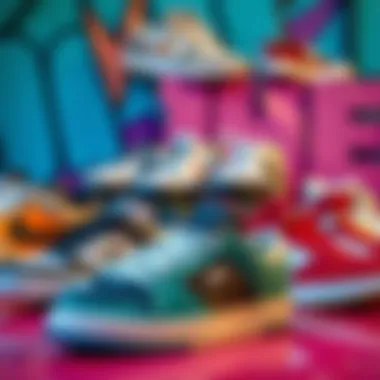

Look for:
- Material: Leather or suede might be great for a polished look, but they hold up better against scuffs. Meanwhile, synthetic materials can offer breathability and lightweight comfort.
- Stitching and reinforcements: A well-constructed shoe features strong stitching, especially around high-wear areas like the toe box.
- Outsole quality: Durable rubber outsoles can significantly prolong the life of your shoes. They provide grip, essential for maintaining footing on your board.
Overall, investing in a more durable pair is a smart move; it preserves not just the shoe but also your feet and your wallet in the long run.
Considerations for Skill Level
Your skating skill level can also determine what kind of skate shoe you should select. Beginners may benefit from a shoe that offers extra cushioning and stability, as they are still building confidence and technique. A heavier shoe can provide the necessary support as you learn to balance and control your movements.
Conversely, advanced skaters, especially those into street skating or tricks, might prefer lighter shoes that enhance agility and feel. Here are some considerations based on skill level:
- Beginner: Look for shoes that offer comfort and cushioning. Brands like Adidas and Vans have lines designed for new skaters.
- Intermediate: You might want to explore models that provide both support and flexibility, as you’ll be trying more complex tricks.
- Advanced: Opt for specific technical features like board feel and grip to enhance performance on tricky maneuvers.
In essence, understanding your skill level should guide your shoe selection process. What works for a pro won't always be suitable for someone just starting out.
"The right skate shoes can feel like an artist’s brush, allowing you to create a masterpiece on your skateboard."
As you take these factors into account, you'll be better equipped to make an informed choice that suits your individual needs and preferences.
The Role of Fashion in Skate Shoes
The intricate relationship between skate shoes and fashion is fundamentally important in understanding contemporary skate culture. Skateboarding transcends mere athleticism; it weaves together elements of art, expression, and personal style. This section will delve into how skate shoes have become a canvas for individuality and what that signifies in the broader landscape of skateboarding.
Streetwear Influence
The ever-evolving nature of streetwear has a significant impact on skate shoes. Brands such as Supreme and Off-White have pushed the boundaries, merging high fashion with skate culture. When you throw on a pair of skate shoes, you’re not just gearing up for a ride; you’re making a statement. The attire worn even before stepping on a deck reflects a collective identity. Skate shoes like the Nike SB Dunk, for example, often collaborate with streetwear labels to create limited-edition releases that capture attention not just on skate parks, but on city streets.
Consider the colorways and materials now utilized in skate shoe production, which mirror current fashion trends. Designers are exploring everything from pastels to bold graphics, and this is not mere coincidence. The connection goes both ways—skate shoes find their way into runway shows as mainstream brands begin to acknowledge the avant-garde nature of skate culture. The blurring of lines between function and fashion is a clear marker of how integral design has became in the performance aspect of these shoes.
"Skateboarding is all about the evolution of style, both in moves and in the gear we wear."
This cultural shift encourages skaters to take pride in their footwear. When a skateboarder wears a fashionable shoe, it not only serves a purpose but also signifies their place in a larger community. Thus, the blend of skate and streetwear reflects a symbiotic relation, bringing attention to both realms.
Custom Design Trends
As skate culture grows, so do opportunities for personal expression, particularly through customized skate shoes. Today’s skaters are not just looking for high performance but also a unique flair that can't be found off the shelf. Some brands offer personalization options, letting enthusiasts input their colors, patterns, and even their names on the shoes.
Consider the likes of Vans, which introduced a custom design platform allowing users to create their own unique styles. Skate shoes have become a form of personal brand, showcasing one’s creativity and unique taste. This trend fosters a sense of belonging. When one sees someone sporting a one-of-a-kind pair of skaters, it’s not just a shoe; it’s a conversation starter, an emblem of shared interests and lifestyle.
In addition to customization, collaborative designs with artists and skaters have also become popular. The crossover with art lends a deeper narrative to skate shoes, embedding them with stories that resonate personally with the wearer. Each pair tells a story, whether it's a tribute to a beloved city, an iconic skate move, or even a social issue.
In summary, the fashion element involved in skate shoes is a dialogue that continuously evolves. The influence of streetwear and customization reaffirms that skate shoes are not merely functional items; they are an integral part of self-expression in skate culture. The implications are profound, indicating that as the scene grows, so do the acts of wearing them with pride. The future promises more innovation and individualization in skate footwear, opening doors for dialogue within the skate community and beyond.
Sustainability in Skate Shoe Production
As the world becomes increasingly aware of the environmental impact of consumer goods, the skate shoe industry is no exception. Skate shoes are an essential part of the skateboarding culture, but their production can lead to significant waste and pollution. Therefore, the push for sustainable practices within this sector is often highlighted not just as a trend but as a necessity.
Opting for sustainable production methods not only helps protect the environment, but it also resonates well with consumers, especially those who value eco-friendliness. Brands that adopt sustainable practices can enhance their reputation, attract a conscious consumer base, and contribute to a greater cause within the skateboarding community. Whether it’s through the use of eco-friendly materials or recycling initiatives, the focus lies on minimizing their carbon footprint without sacrificing style or performance.
Eco-Friendly Materials
In the world of skate shoes, material selection plays a crucial role in sustainability. Manufacturers are beginning to turn to eco-friendly materials such as organic cotton, hemp, and recycled plastics.
Benefits of Eco-Friendly Materials include:
- Reduced Chemical Use: Materials like organic cotton minimize the use of harmful pesticides and fertilizers.
- Lower Carbon Footprint: Many brands now source their materials locally or from sustainable ports, which drastically reduces transportation emissions.
- Recycled Content: Some companies are integrating recycled components from old shoes into their new designs, reducing the need for virgin materials.
For example, Adidas has made strides by releasing their Parley collection, which uses plastic waste collected from oceans and shores to create new sports shoes. This innovative step shows how the industry can take responsibility and lead the charge towards a sustainable future.
Recycling Programs and Initiatives
In addition to the materials used, recycling programs are another vital aspect of sustainability in skate shoe production. Many brands are now implementing initiatives that encourage customers to return their worn-out shoes for recycling rather than discarding them. This creates a closed loop in the footwear lifecycle.
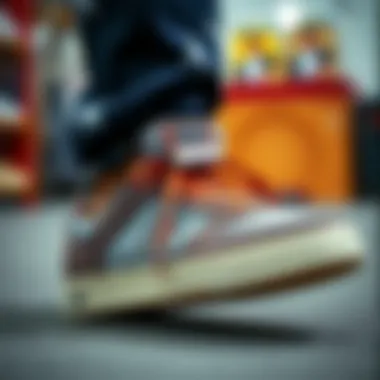

"Recycling not only helps keep landfills smaller, it also offers a chance for new creations without the added pressure on natural resources."
Key Features of Recycling Programs:
- Incentives for Returns: Brands often offer discounts or loyalty points for customers who return their old shoes, making it a win-win situation.
- Partnerships with Environmental Organizations: Collaborating with organizations focused on sustainability helps elevate the credibility of the brand’s efforts.
- Innovative Recycling Tech: Some companies invest in technology to convert old materials into new shoe fabrics, addressing the issue of waste efficiently.
As skateboarding continues to evolve, the importance of sustainability in skate shoe production will only continue to grow. Brands that recognize this shift are not only paving the way for future skate shoe innovations but are also contributing to a more sustainable planet.
Care and Maintenance of Skate Shoes
When delving into the realm of skate shoes, one cannot overlook the essential practice of proper care and maintenance. Infusing skate shoes with longevity not only ensures they remain visually appealing but also preserves their performance on the board. After all, a good pair of skate shoes is akin to a trusted skateboard; both require some TLC to perform at their peak.
Cleaning Tips
Regular cleaning of skate shoes can significantly extend their usability. That worn-out, muddy look does little for your style or grip. Here are some straightforward cleaning tips:
- Use a Soft Brush: A simple toothbrush works wonders for getting rid of dirt lodged in the grooves.
- Mild Soap and Water: Create a mixture of warm water and mild soap. Soak the brush, and scrub gently, avoiding excessive soaking which can cause damage.
- Avoid Washing Machines: Although it's tempting, the high-pressures and spinning can ruin shoe structure.
- Dry Naturally: Instead of throwing them in the dryer, let your shoes air dry away from direct sunlight which can warp materials,
- Unlace and Remove Insoles: Cleaning these parts separately ensures they get thorough attention and prevents unnecessary buildup.
"A clean shoe isn’t just about looks; it impacts your grip and how well you ride. Dirty shoes can affect footing on the board."
Extending Lifespan
To get the most out of your skate shoes, you must be smart about how you use and store them. Following these tips can help maintain your shoes' integrity:
- Rotate Your Shoes: If you have multiple pairs, switch them around. This allows each pair to "rest," maintaining their cushioning and support.
- Store Properly: Avoid cramming shoes into tight spaces. Store them in a cool, dry place and keep them away from direct sunlight when not in use.
- Regular Inspection: Check for any signs of wear and tear, particularly at the seams and soles. Addressing minor issues early can prevent them from becoming significant problems later.
- Use Protective Sprays: Investing in a good spray can help repel water and dirt, keeping your shoes looking fresh for longer.
In essence, care and maintenance aren’t just chores; they are integral to preserving the performance and aesthetic value of skate shoes. With a little effort, skateboarders can ensure their footwear lasts longer, enhancing both their riding experience and fashion statement.
Community and Skate Shoes
When we think about skate shoes, there's a fascinating community intertwined with the culture that breathes life into this industry. Skate shoes embody more than just rubber soles and stylish designs; they carry stories, experiences, and the spirit of collaboration within the skateboarding community. This bond not only enhances the performance of individuals on their boards but also fosters a sense of belonging—a vital aspect for both amateur and professional skaters.
Brand Collaborations with Skaters
The partnership between skate shoe brands and professional skaters plays a crucial role in driving innovation and trendsetting in the industry. These collaborations often lead to unique designs and advanced technologies tailored for the actual needs of skaters. An example might be the collaboration between Eric Koston and Nike SB, which produced the iconic Koston 1 shoe. This shoe was specifically designed to cater to the demands of street skating but also embraced an aesthetic that appealed to a wider audience.
Moreover, skaters often have a greater influence on product development than the average consumer might realize. By working closely with brands, skaters can provide feedback on fit, comfort, and functionality. This collaborative effort benefits both parties, leading to better products and greater engagement with the skate community. The visibility gained from these partnerships reinforces a skater's brand as much as it does the shoe brand’s. For instance, the ongoing partnership between Vans and various prominent skaters has solidified Vans’ place in skate culture, showcasing their shoes at events and competitions worldwide.
Events and Competitions Focused on Footwear
Events focusing on skate shoes are pivotal for showcasing the latest trends and innovations in the industry. Competitions such as the Street League Skateboarding, or SLS, not only highlight the skills of skaters but also the gear they use. At these events, the footwear worn by participants can become a significant talking point, influencing trends among enthusiasts and novices alike.
These gatherings provide a platform for brands to unveil new models and technologies directly to their target audience. For example, at the annual Vans Park Series, skate shoes are often one of the key focuses. Beyond just competitions, there are festivals and showcases dedicated to skate culture where brands collaborate on limited edition releases in conjunction with event festivities. This blend of competition and fashion reflects how integral skate shoes are to both performance and personal style within the community.
"Skate shoes are not just about looking good; they’re about delivering performance and style that resonates with the culture."
The continuous adaptation of skate shoes to fit the evolving standards of performance within the skateboarding realm proves how interconnected community and footwear are. As skateboarding grows, so too does the creative freedom of both skaters and brands to push the envelope on what skate shoes can achieve, making it an ever-evolving essence of skate culture.
Epilogue and Future Directions
The realm of skate shoes is not just about strapping on a pair of sneakers; it’s about embracing a lifestyle intertwined with performance and artistic expression. In the conclusion of this exploration on skate shoes, we can underline their significance not only in enhancing the skateboarder's experience but also in mirroring cultural shifts and ethical considerations. This wraps up an enlightening discussion that ties together the practicality of skate shoes with their pivotal role in the skateboarding community.
Trends to Watch
As we glance into the future, several trends are shaping the landscape of skate footwear. Here are a few noteworthy developments to keep an eye on:
- Tech-Enhanced Design: Expect to see more shoes incorporating advanced cushioning technologies and grip enhancements that cater to the athletic needs of skateboarders.
- Sustainable Footwear: Brands are beginning to shift towards eco-friendly materials and ethical production methods. For instance, companies like Nike and Adidas are investing in sustainable practices, embracing recycled materials, and reducing their carbon footprint.
- Fashion Collaborations: The collaboration between skate brands and high-fashion labels continues to thrive. Skate shoes are no longer just functional; they are becoming a fashion statement, appealing to a broader audience.
- Customization and Personalization: With increasing demand for individuality, some brands might offer customizable options, allowing skateboarders to express their personal style more dimensionally.
These trends underscore a broader cultural movement towards innovation, sustainability, and individuality, which marks the evolving identity of skate shoes.
"The skate shoe of tomorrow will blend resilience with style, capturing the spirit of a generation seeking more than just a functional product."
Evolving Standards in Skate Footwear
The standards for skate shoes are continually evolving, shaped by both technological advancements and the voices of skateboarders themselves. Here’s what is becoming increasingly important:
- Performance Metrics: As skateboarding techniques evolve, the demand for shoes that provide superior performance has grown. This includes better shock absorption, heel support, and grip.
- Flexibility and Durability: High-quality materials that can withstand the rigorous demands of skateboarding, while still allowing for flexibility, are now expected rather than requested. Skate shoes must keep up with the tricks and techniques that push the boundaries of the sport.
- Inclusive Sizing: There is a call for improved sizing that considers diverse foot shapes and sizes. Brands that offer a range of fits are more likely to attract a wider community of skaters.
- User Feedback as Standard: Brands that prioritize direct feedback from users — through social media platforms or skate events — often adapt quicker to meet changing demands, fostering a collaborative environment between manufacturers and skaters.
In summary, the conclusions drawn here not only highlight the past and present of skate footwear but also paint an exciting picture of where it’s headed. Skate shoes are not just footwear; they are a canvas for expression, innovation, and community engagement.













